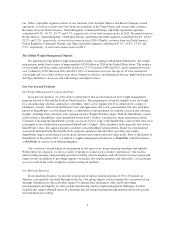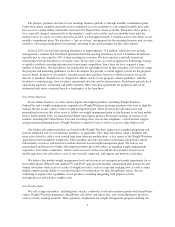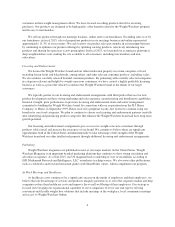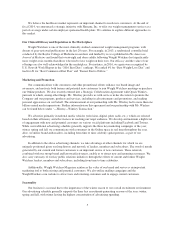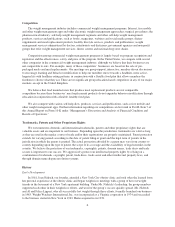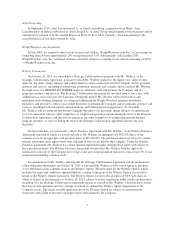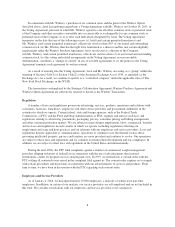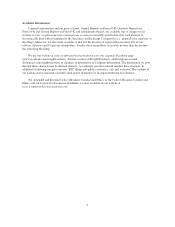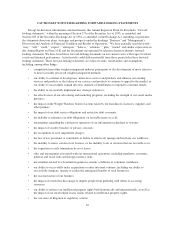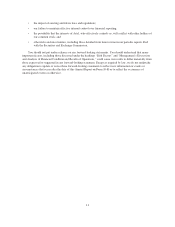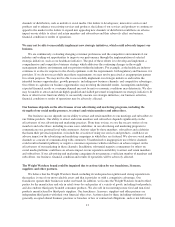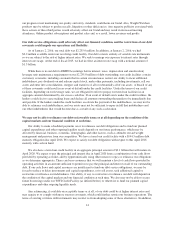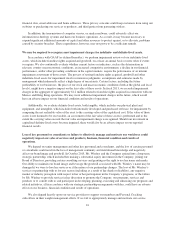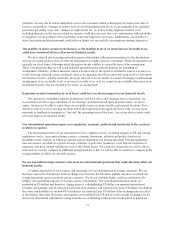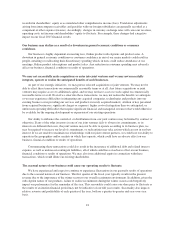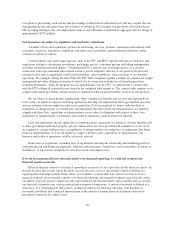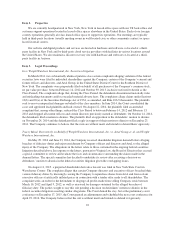WeightWatchers 2015 Annual Report Download - page 15
Download and view the complete annual report
Please find page 15 of the 2015 WeightWatchers annual report below. You can navigate through the pages in the report by either clicking on the pages listed below, or by using the keyword search tool below to find specific information within the annual report.Item 1A. Risk Factors
You should consider carefully, in addition to the other information contained in this Annual Report on
Form 10-K and the exhibits hereto, the following risk factors in evaluating our business. Our business, financial
condition or results of operations could be materially adversely affected by any of these risks. The following
discussion of risks is not all inclusive but is designed to highlight what we believe are the most significant risks
that we face. Additional risks and uncertainties, not presently known to us or that we currently deem immaterial,
may also impair our business, financial condition or results of operations.
Competition from other weight management industry participants or the development of more effective or
more favorably perceived weight management methods could result in decreased demand for our services
and products.
The weight management industry is highly competitive. We compete against a wide range of providers of
weight management services and products. Our competitors include: commercial weight management programs;
Internet, free mobile and other weight management apps and other electronic weight management approaches;
surgical procedures; the pharmaceutical industry; self-help weight management regimens and other self-help
weight management products, services and publications, such as books, magazines, websites and social media
groups; dietary supplements and meal replacement products; healthy lifestyle services, products and publications;
weight management services administered by doctors, nutritionists and dieticians; government agencies and non-
profit groups that offer weight management services; fitness centers and national drug store chains. Additional
competitors may emerge as new or different services, products or methods of weight management are developed
and marketed. More effective or more favorably perceived diet and weight management methods, including
pharmaceutical treatments, fat and sugar substitutes or other technological and scientific advancements in weight
management methods, also may be developed. This competition may reduce demand for our services and
products.
The purchasing decisions of weight management consumers are highly subjective and can be influenced by
many factors, such as brand image, marketing programs, cost, consumer trends and perception of the efficacy of
the service and product offerings. Moreover, consumers can, and frequently do, change weight management
approaches easily and at little cost. For example, fad diets and weight loss trends, such as low-carbohydrate diets,
have adversely affected our revenues from time to time. More recently, our revenue was adversely affected by
the popularity of mobile technology, which has led to increased trial of free mobile and other weight
management apps and activity monitors. Any decrease in demand for our services and products may adversely
affect our business, financial condition or results of operations.
If we do not continue to develop new, innovative services and products or if our services and products do
not continue to appeal to the market, or if we are unable to successfully expand into new channels of
distribution or respond to consumer trends, our business may suffer.
The weight management industry is subject to changing consumer demands based, in large part, on the
efficacy and popular appeal of weight management programs. The popularity of weight management programs is
dependent, in part, on their ease of use, cost and channels of distribution as well as consumer trends. For
example, the increasing focus of consumers on more integrated lifestyle and fitness approaches rather than just
food, nutrition and diet could adversely impact the popularity of our programs. Our future success depends on
our ability to continue to develop and market new, innovative services and products and to enhance our existing
services and products, each on a timely basis, to respond to new and evolving consumer demands, achieve
market acceptance and keep pace with new nutritional, weight management, technological and other
developments. We may not be successful in developing, introducing on a timely basis or marketing any new or
enhanced services and products. Additionally, new or enhanced services or products may not appeal to the
market or the market’s perception of us may not evolve alongside our services and products. Our future success
also will depend, in part, on our ability to successfully distribute our services and products through appealing
12


